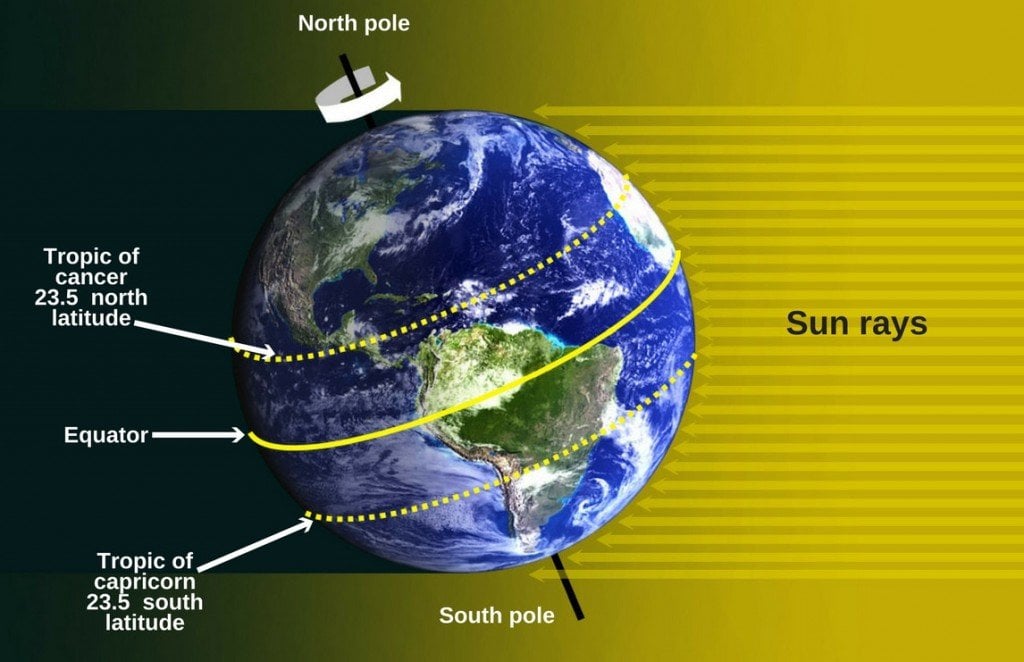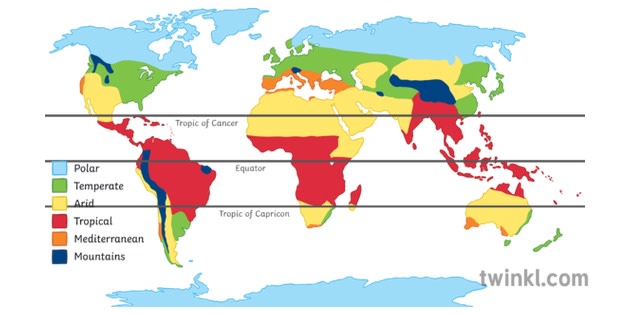Compare Vegetation Near the Poles and Vegetation Near the Equator
Because of the cold temperatures and short growing season trees and other slow-growing plants are unable to survive. In Equator the temperature is hot while in the Poles it is cold.

Why Are Tropical Regions Hotter Than Equatorial Regions Science Abc
Climate soil the ability of soil to hold water and the slope or angle of the land all determine what types of plants will grow in a.
. The elements of climate and natural vegetation include solar radiation temperature atmospheric pressure wind speed and direction humidity and precipitation. What causes biomes and vegetation to change. Equator is an imaginary circle which divides the Earth in half.
A closely related and perhaps more common misconception is that the equator is warmer than the poles because the equator is significantly closer to the sun than are the poles ie. The gradient is pretty dramatic for. Forest grassland tundra desert and ice sheet.
The growing season gets longer from the poles to the equator. Figure 3 shows that the North Pole is near the middle of the Arctic Ocean. Compare this to the acceleration due to gravity which is about 98 ms 2 and you can see how tiny an effect this is - you would weigh about 03 less at the equator than at the poles.
The number of animal and plant species peaks near the equator and drops off toward the poles. 15 Mkm2 shelf ice 170 Mkm2 sea ice almost 34 Mkm2 of reflective surface around the south pole. The North Pole lies 90 on the north of the equator and the South Pole lies 90 on the south of the equator.
Compare the Antarctics 180 Mkm2 ice area at minimum to the Arctic maximum sea ice area of only 140 Mkm2. The land located in the temperate region of the world between about 30 and. Compare vegetation near the poles and vegetation near the equator.
RECOGNIZING CAUSE AND EFFECT One reading skill is the ability to recognize cause and effect. As latitude and altitude increase biomes and vegetation change. One of the more recent studies on this issue concluded that species turnover is higher in temperate regions.
The theory is that in the tropics theres more room for fine-scale specialization among speciesnot just birds that eat seeds but birds that eat only one kind of seed in one part of the environment branches high in the forest canopy for example. TROPICAL EQUATORIAL CLIMATE. Both are units of measure.
Changes in latitude. These areas have distinct types of plants soil and weather patternsVegetation regions can be divided into five major types. Equator to pole wont.
Compare vegetation near the poles and vegetation near the equator. While the Poles are the two points North Pole and South Pole that are crossed by the axis of rotation of the Earth. The distance north or south of the equator as measured in degrees is called what.
Changes in latitude and. The warmth and the humid are the reason for. Both are units of measure.
The aptest modern definitions of climate refer to it as being made up of the total. The equator is the imaginary circle which cuts the spherical Earth exactly in the middle ie. Among all of the worlds natural kingdoms however one rule reigns supreme.
Compare vegetation near poles and vegetation near the equator. For example the trees of tropical rain forests usually grow closer to the equator while the mosses and lichens of the tundra usually grow closer to the poles. But with increasing latitude the climate becomes more seasonal and more difficult to.
The temperature may rise above freezing for only a couple of months each year. The equator bulges out. Scientists divide the Earths land into what are called vegetation regions.
For example near the poles the growing season is very short. There is little diffusion of sunlight thus most of the countries. The gravitational acceleration is 978 m s2 in Equator while in the Poles it is 983 m s2.
Near the poles the tundra supports mosses and lichens. Read each question and. The land located in the temperate region of the world between about 30 and 60 north.
The equatorial climate zone is situated around the equator and cover wide areas in South America Central Africa and South-East Asia. Its greatest extent is found in the lowlands of the Amazon the Congo Malaysia and the East Indies. Latitude is the distance north or south of the equator that is measured in degrees while altitude is the height of an object above sea level.
North Pole and South Pole. Near the equator the tropical rain forests support certain trees. For example the trees of tropical rain forests usually grow closer to the equator while the mosses and lichens of the tundra usually grow closer to the poles.
Up to 24 cash back As latitude and altitude increase biomes and vegetation change. As latitude and altitude increase. There are lots of different species at the tropics but their numbers drop off sharply as you move toward the poles.
They are different because they grow more and closer. Fossil evidence shows this trend goes back millions of years. The distance north or south of the equator is called.
Near the equator the tropical rain forests support cer-tain trees. Near the poles the tundra supports mosses and lichens. In general the climate is regarded as the predominant atmospheric condition in a certain area.
Typical features of this climate are all year round high daily and nightly temperatures as well as heavy rains falling almost every day. The equatorial hot wet climate is found between 5 and 10 north and south of the equator. A pole consists of two points.
One of the most common and persistent scientific misconceptions is that Earths seasons are caused by Earths distance from the sun. There are multiple theories as to why this is the case. This means that the centripetal acceleration at the Equator is about 003 ms 2 metres per second squared.
Further away from the equator the influence of the on-shore Trade Winds gives rise to a modified type of equatorial climate with monsoonal influences. What causes climate to vary. The main factors that determines what plants grow in a biome are.
How are they different. Latitude is the distance north or south of the equator that is meas-ured in degrees while altitude is the height of an object above sea level. They both affect the changes in climate.
It has fertile soil. This idea is also referred to as the latitudinal diversity gradient meaning that as you move from the equator towards the poles diversity lessens. How are latitude and altitude similar.

Sample Of Pictorial Input Draw Label On World Biomes Glad Strategies Biomes Next Generation Science Standards


Comments
Post a Comment